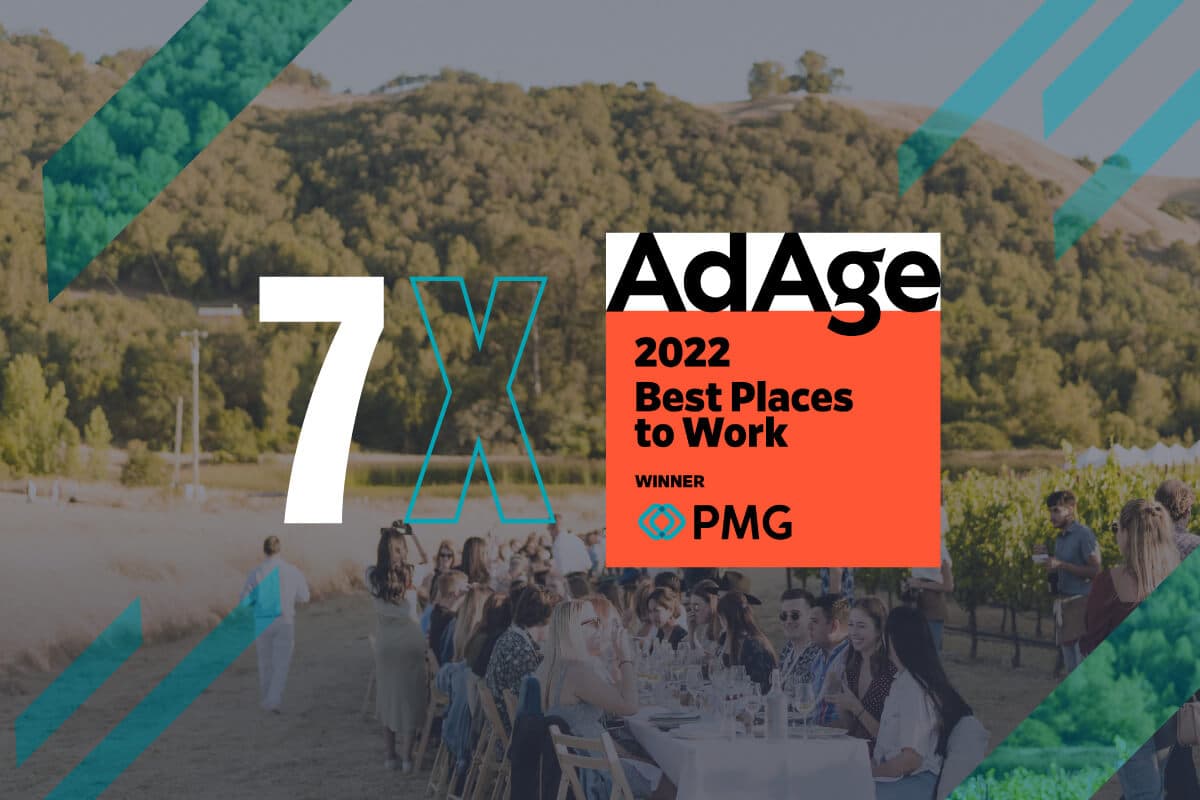Accessibility Tools
PMG Digital Made for Humans
“Privacy Moved from the Tech Section to the Front Page:” PMGers on the Trends that Defined 2021
7 MINUTE READ | December 22, 2021
“Privacy Moved from the Tech Section to the Front Page:” PMGers on the Trends that Defined 2021
Bradley Cooper, Senior Content Writer
Bradley Cooper is the founder and CEO of ContentP, a content creation company. She’s been a content marketer for over 10 years and has written for PMG, Forbes, Entrepreneur, Inc, and many other publications on blogging and website strategy.

For our last blog post of the year, we asked account directors, client strategy partners, media practitioners, and creative strategists from across PMG for their take on the trends that defined 2021, and what they mean for the future of marketing and technology. It was no surprise that NFTs, the metaverse, and all things web3 claimed the top spot, marking one of the most profound industry shifts on our radar. But beyond these buzzworthy topics are fundamental changes in consumer behavior that are transforming the digital landscape today and will make for an interesting year ahead.
The speed of change in the digital landscape and unpredictability of consumer behavior over the past year will continue, emphasizing the importance of prioritizing full-funnel planning and digital transformation while maintaining an agile approach to engaging with customers.
Consumer privacy remains a top priority amid the deprecation of third-party cookies and new measurement frameworks by Apple and others, leading to a greater focus on bolstering loyalty programs and identifying new measurement solutions in the months to come.
Consumer interest and capital investment in NFTs and digital goods, cryptocurrencies, and the metaverse will continue as web3 actualizes into the future of digital experiences. Early movers are staking their claim — whether through exclusive collaborations, developing digital assets that mimic physical world products, or minting their own NFT collections — shortening the path from our current web2 environment to the web3 future.
Consumer behavior fundamentally shifted during the pandemic, from ecommerce adoption to a renewed focus on wellness and the reemergence of leisure travel, as marketers have had to adapt to a dynamic environment over the last two years. Brands continue to invest heavily in prioritizing digital transformation, building data and technology infrastructure, and finding partners who can strategically use data to marry strategy, media, creative, and insights to better navigate the new consumer environment.
“We saw a lot of scenario planning, re-forecasting, and pivots in strategy this year as marketers reacted to public safety guidelines, privacy changes, and new consumer behaviors,” said Tom Burke, senior director of client development at PMG. “This required agility in thinking and execution, along with close collaboration among agencies, brands, media, and tech partners. An agility-first mindset has emerged coming out of 2021, and we’re seeing that more brands are eager to break down the silos between strategy, media, and creative as the need to move quickly intensifies.”
Automation, new platform capabilities, and the need to develop new measurement solutions this year pushed marketers to consider how to move up the funnel and diversify their media mix for long-term stability. Rethinking the traditional path for decision-making will be a top priority for many brands as they work to create authentic connections with customers no matter what platform, device, or channel they are on. Uncertainty is the new normal, but by leveraging truly holistic, omnichannel media plans with diversified spending across platforms and channels, brands can minimize the impact of any disruptions.
“Uniting strategy, media, creative, and insights will push brands into the future.”Tom Burke, Senior Director of Client Development, PMG
With the launch of Apple’s iOS 14.5 and the announcement that Google Chrome will eliminate third-party cookie tracking, data collection and privacy were top of mind for many marketers. But, after Google Chrome web trials with privacy sandbox proposals like FLoC and Fledge didn’t come to fruition as planned, Google announced delays in the timeline. For some brands, this was welcome news — and additional time to develop mitigation strategies — but for others, it emphasized the need to accelerate investments into customer data platforms and other marketing technology to activate on first-party data.
Though Google has delayed phasing out third-party cookies until 2023, the impact is already being seen in digital attribution, ad effectiveness, and ad costs on platforms like Facebook as tech platforms increasingly prioritize consumer privacy.
“Consumer privacy moved from the tech section to the front page, as data collection practices drew greater scrutiny than ever before.”
Jason Hartley, Head of Search, Shopping and Social, PMG
“In response to some of these changes, brands are recognizing the value of first-party data and customer intelligence for powering greater brand loyalty, media performance attribution, and behavioral retargeting,” said Laurie Miller, PMG’s head of analytics. “We’re seeing business leaders quickly adopt customer data platforms and putting greater emphasis on bolstering loyalty programs for driving engagement and sales.”
More retailers can be expected to unveil refreshed loyalty programs that create community among customers, enable exclusive product drops, and more, all while collecting customer data that helps inform future business decisions and digital marketing programs.
It’s no secret that the digital ad economy is undergoing a digital transformation of its own, as tech platforms give users greater control over their data, and marketers and publishers rethink how audience data is captured and used. Even retail brands like Target are catching on to the value of first-party data and the advertising opportunities that exist within its digital ecosystems, introducing retail media networks that provide new revenue streams and new avenues for brands to reach customers. From data clean rooms and behavioral targeting to retail media networks, marketers are adopting a test-and-learn approach for identifying the best ways to acquire and action off customer data in new and interesting ways.
“The ability to leverage known customer attributes effectively to provide a positive experience for shoppers will help brands keep pace in this rapidly evolving climate,” said Julianne Manoogian, senior director of engagement consulting at PMG. “In 2022, more brands will be looking to scale and grow their first-party data portfolio and prioritizing how it can be used as a valuable corporate asset.”
Advancements in augmented and virtual reality, digital goods, fashion, wearable technology, digital currency, and virtual experiences are propelling the metaverse to become the successor to the mobile internet, and an extension of what comes next for brand innovation, creativity, and engagement. In recent months, capital investment and interest in all things web3 has skyrocketed, as each passing day brings a new exclusive partnership and retailer x NFT announcement. Digital goods, cryptocurrencies, and exclusive NFT collections will only grow in popularity next year as early adopters stake their claim in the metaverse and the future of digital experiences.
Related: PMG’s Joe Flowers on web3 opportunities for brands
If the speed of change and unpredictability of 2021 is any indicator for the year ahead, 2022 will require brands to remain agile and navigate changes with authenticity and focus. Whether it’s NFTs or CTV, BNPL or DAOs, there are countless threads ready to be pulled for engaging customers and enabling a holistic strategy shaped around the potential and possibilities of digital.
Stay in touch
Bringing news to you
Subscribe to our newsletter
By clicking and subscribing, you agree to our Terms of Service and Privacy Policy
As the size and complexity of the customer journey continues to span more channels and touchpoints, brands that prioritize their brand values and customer needs are best positioned to test and scale new opportunities as they become available. If there’s anything to take away from the past 18 months, it’s that change is inevitable, but brands that stay true to their values and in tune with customers can come out ahead of whatever comes next.










